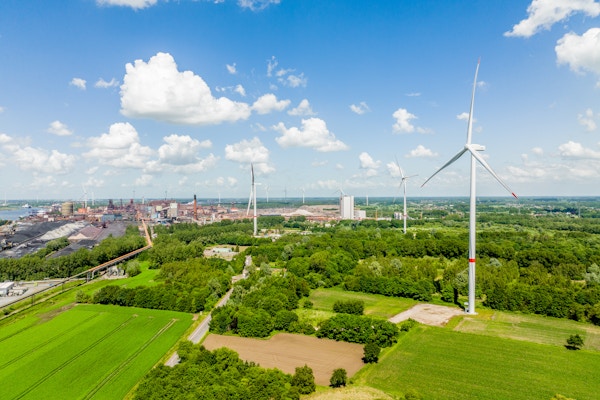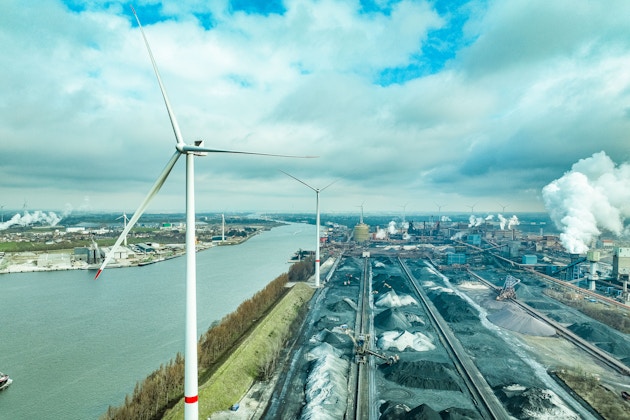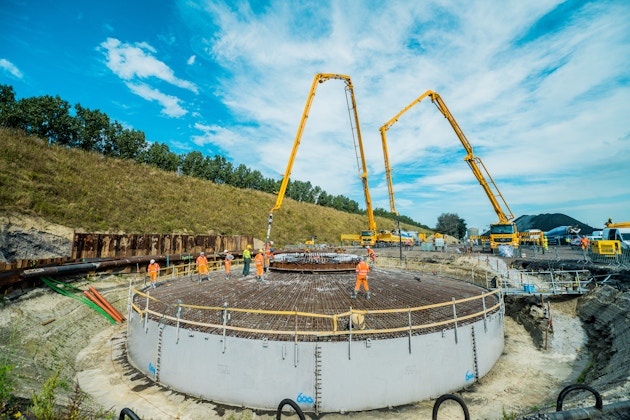
Q&A: Storm is building Belgium's first subsidy-free wind farm at the ArcelorMittal site in Ghent
Storm is building Belgium's largest wind turbines at the ArcelorMittal site in the Port of Ghent. The site was opened this morning by Flemish Minister Zuhal Demir. ArcelorMittal will purchase all the electricity generated by the wind turbines at a fixed tariff for twenty years. The wind farm does not rely on the green certificate system, making it the first subsidy-free wind farm in Belgium.
This Q&A provides answers to the most important questions relating to the project.
Q&A
The new Storm wind farm at the ArcelorMittal site will be built without subsidies. Does this mean that wind energy in Flanders will no longer need to be subsidised? No. A lot of preconditions have to be met before a wind farm can be built without green certificates. For the time being, only the very largest wind turbines can be built without subsidies, and then only in locations where there is a lot of wind. Moreover, a customer with the reputation for being extremely creditworthy has to be prepared to purchase the power at a fixed tariff for 20 years. Like ArcelorMittal, in this case. The wind turbines that Storm is building for ArcelorMittal are the largest in Belgium, with a rotor diameter of 162m, a tip height of up to 230m and a generator of 6 MW per turbine.
How does ArcelorMittal benefit from this? ArcelorMittal will purchase all the power generated by the new Storm wind farm for twenty years at a fixed tariff. This tariff is lower than the current wholesale tariff for grey electricity (EUR 61.83/MWh in the year-ahead market at close of business on 8 June 2021). Therefore, ArcelorMittal has secured a cheap, long-term electricity supply, which also comes entirely from a renewable source.
Has wind energy really become the cheapest way to generate electricity? Yes. With or without subsidies, one MWh of electricity generated by a new wind turbine costs less than one MWh of electricity generated by, for example, a new gas-powered plant, coal-powered plant, biomass power plant or nuclear power plant. This was revealed by several recent studies, including those by the International Energy Agency (IEA) and Lazard.
If wind energy is so cheap, will this be reflected on my electricity bill? Absolutely. Any new, alternative power plant built in Belgium – using grey or green electricity - has a higher cost per MWh generated than a new large wind turbine, and therefore needs more subsidies. Due to the fact that the electric generation park in Belgium is very outdated, many new generation units are needed in the short term - and no new plant is cheaper for the consumer than large wind turbines.
Why has wind energy has become so cheap? Several technological evolutions underlie the rapid decrease in the cost of wind energy. The most important change has to do with the size of the wind turbines.
The amount of energy a wind turbine captures from the wind increases proportionally to the surface area of the rotor (i.e. the length of the blades). However, the total cost does not increase proportionally: a longer blade costs slightly more than a shorter one, and the mast also has to be a little higher, but on the whole the difference in the investment cost of a wind turbine is limited.
In general, the principle applies that a larger turbine generates (much) more electricity and that it does so (much) more cheaply. The difference is huge: as a rule of thumb, we can assume that a large wind turbine (rotor 162m, tip 230m) generates two to three times more electricity than a small one (rotor 100m, tip 150m) - and at a significantly lower cost. However, this does not mean that there is no place for small wind turbines (tip height 150m or smaller): they too generate cheap renewable energy, and we need all the resources we can muster if we are to achieve the climate goals.
If the cost of wind energy is decreasing so rapidly, shouldn't we wait for it to decrease even further? Today, wind turbines are already cheaper than any new power plant. The rapid decrease in the cost of wind turbines is mainly due to the larger dimensions of the rotors. Of course, there is a limit to this: in a region like Flanders it is difficult or even impossible to install wind turbines on land with rotors of 200m or larger. Therefore, the chance that the cost will decrease further is small. This is also revealed by various studies: the rapid decrease in the cost of wind energy has levelled off in the past year and is now almost at the economic optimum.
Is wind energy highly subsidised in Flanders? In Flanders, wind energy is subsidised via the system of green power certificates. A new, large wind turbine licensed in Flanders in 2021 will still receive EUR 9.25/MWh in support via green power certificates (banding factor 0.0995). This is less than one fifth of the income the wind turbine receives from selling electricity on the market and ten times less than the EUR 90/MWh that was paid up to 8 years ago.
Will all wind turbines be able to do without subsidies in the future? Possibly. However, it remains to be seen whether this is also the cheapest option for consumers. Recent research in the Netherlands shows that wind energy is so cheap today partly because banks provide cheap loans for the construction of wind turbines. The loans are so cheap partly because the government - through the support mechanism - guarantees the electricity tariff that a wind turbine will receive for twenty years, and because the imbalance cost is also covered in the same way. The abolition of this mechanism could lead to an increase in the cost involved in financing wind turbines, which would also increase the price for the consumer. Therefore, we will have to wait and see which scenario is the cheapest for society in the long run: with or without a (limited) subsidy.
How many more wind turbines does our country actually need? There are various scenarios for the future supply of electricity in our country.
Virtually all the scenarios come to the same conclusion: to keep electricity bills as low as possible and to make society climate-neutral, by 2050 the vast majority of our energy consumption will be electrified, and the largest share of electricity will come from wind turbines and solar panels.
One recent study was conducted by EnergyVille. In its main scenario, it concludes that at least 7.8 GW of onshore wind energy will be needed in Belgium by 2045. That is more than a threefold increase in current capacity (2.3 GW at the end of 2020).
Do we have room for so many additional wind turbines? Yes, this has recently been researched as part of EnergyVille's BREGILAB project. The BREGILAB project defined the available space and generated an optimal distribution of turbines, and determined the potential for onshore wind turbines in Belgium at 20 GigaWatt (GW). That is almost nine times current capacity (2.3 GW at the end of 2020).
Will it be possible for so many wind turbines to be approved? I thought local residents were always opposed to a wind farm being built in their area? Actually, it is not that bad. There is substantial support for wind energy in Flanders. In 2014, the Flemish Energy and Climate Agency, in association with the VREG, commissioned an annual study into the level of support.
The most recent version of the study, from 2020, concludes that 69% of Flemish people are in favour of wind energy, 27% are neutral and only 3% are against it.
This positive attitude also applies to wind turbines in their municipality: 57% are in favour, 35% are neutral and only 9% are against them.


